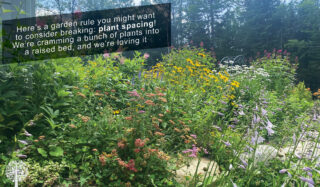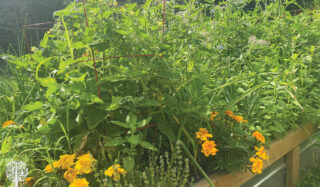Rules? What Rules? The Summer I Ignored Spacing In The Garden
They say rules are made for breaking, so this year in my garden, I’m ignoring an essential growing ‘rule’: plant spacing. After years of following the recommended spacing on the back of seed packets, my raised beds are planted intensively this season. Tidy rows? Not in my garden. The result is a lush plant paradise that is productive, pest-free, and pleasing to the eye.
This Sounds Chaotic…
Some call it ‘chaos gardening’ or ‘horticultural disobedience,’ which implies growing plants haphazardly and allowing nature to do its thing. Nicole Johnsey Burke of Gardenary calls it ‘The Gardenary Method.’ Whatever you want to call it, it’s liberating.
After interviewing Stephanie Rose about her experiences with chaos gardening and reading Johnsey Burke’s book Kitchen Garden Revival, I was inspired to break free from the confines of proper plant spacing to maximize food production in my available space.

Hobby Growers, Rejoice!
I have six large raised beds and two smaller galvanized steel hexagons to grow in, which don’t offer much room if you follow strict spacing guidelines. In this YouTube video, Johnsey Burke talks about how the spacing recommendations on the back of seed packets are directed at farmers growing in the ground, not for home hobby growers. Goodbye, tape measure!
Taking Nature’s Lead
Rose and Johnsey Burke suggest looking at how trees, shrubs, and flowers grow in a forest or national park. There is no rhyme or reason or empty space. Plants intermingle and grow together in layers. Expect some losses; the plants that make it were always meant to survive.
How I Ignored Plant Spacing Rules
I followed the planting guide recommended by Kitchen Garden Revival. The book suggests beginning in the center of the raised beds with tall plants like tomatoes, borage, and squash, especially if you plan to stake them. At this point, place trellises, obelisks, and arches into the beds so climbers, like cucumbers and pole beans, have something to grab onto.
Next, plant the medium-sized crops on either side of the large plants. I have peppers, eggplant, bush beans, lettuce, chard, and snap peas.
Once all of my seedlings were in place, I planted seeds in bare pockets. Root veggies like garlic, beets, radishes, celery, and carrots grow wherever there’s space.
Along the outer perimeter of my garden beds, I have flowers like nasturtiums, marigolds, and zinnias, culinary herbs such as parsley, mint, oregano, sage, and medicinal plants like hyssop and lavender. The borders of my garden always look so pretty and colorful, perfect for attracting pollinators!

Planting Order for Spacing Plants
To sum up, here’s what the planting order should look like:
- Plant large plants.
- Plant medium plants.
- Plant small plants.
- Plant seeds.
- Plant borders with herbs and flowers.
The Six-Week Rule After Planting Your Garden
Johnsey Burke says six weeks after planting your garden, you shouldn’t see any bare soil anywhere. If you do, I recommend throwing some more seedlings, flowers, or seeds in there. I’ve been succession planting with radish, beans, and carrots to fill in any areas with bare soil, which leaches nutrients and water more quickly and becomes infested with pests sooner than covered earth.
The Pros Of Intensive Planting
This intensive planting method confuses pests because there’s too much to choose from, some of which they’ll hate. Gardenary says you can expect high yields, not only because you’ve crammed so much into one space but because the warmth of all the plants together boosts fruit and flower production!
Inspecting the garden is slightly more challenging with so many plants in one space (it’s chaos!), but this is a great excuse to step out into my happy place every day. I’ve been a rule follower for most of my life, but I’m so glad I finally got around to breaking this one!